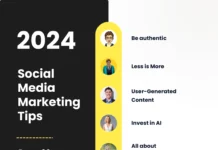
Creating fresh content regularly can be challenging and time-consuming. Wouldn’t it be nice if you could extend the life of your existing content while also enhancing your SEO strategy? Good news: You can!
Repurposing content is not only a practical approach but also an effective one for better search engine rankings. So, let’s explore six effective ideas to repurpose content for SEO.
6 Practical Examples of How To Repurpose Content for SEO
1. Turn Blog Posts into Podcasts
The Concept
Changing a written blog post into a podcast episode is a fantastic way to reach a different demographic of your audience—the auditory learners and the busy folks who consume content on the go.
Explanation and Example
For instance, if you have an insightful blog post titled “10 Steps to Starting Your Own Business,” you can create a podcast episode using the main points as your script. But don’t just read the post verbatim. Expand on each point, adding layers of nuance, personal anecdotes, or even humor.
Furthermore, you could invite an industry expert or a successful entrepreneur to contribute to the conversation, adding value and another dimension to your repurposed content. The podcast format enables you to dive deeper into the topics, perhaps answering questions that your original blog post might have generated. And, of course, you can link back to the original post in your podcast description, which can improve its SEO ranking.
Another Example: If you’ve written a blog post about “The Benefits of Meditation,” consider converting it into a guided meditation session in podcast format. You could also collaborate with a meditation expert to offer additional tips and exercises, making the podcast a supplementary resource to your original article.
2. Create Infographics from Research Articles
The Concept
Visual content, like infographics, is easier to consume and share, making it a valuable asset for SEO. By simplifying complex data or concepts, you make your content more accessible, which can increase its online visibility.
Explanation and Example
Take, for instance, a research article you’ve written on the “Top Digital Marketing Trends of 2022.” This article could be rich in data and valuable insights, but its length might deter some readers. Extracting the key points and representing them visually in an infographic can make the information more digestible and shareable.
To take it further, you can share this infographic on various platforms like Pinterest or Instagram and ask influencers in your industry to share it as well. Each share could serve as a potential backlink to your original article, improving its SEO.
Adding images of infographics like these not only enhances your readers’ experience but also serves as another channel for SEO optimization, as search engines also index images. Just make sure to properly title and tag each image to maximize its SEO impact.
Another Example: If you have an article that discusses “The Effects of Climate Change on Marine Life,” you could create an infographic that visualizes the declining populations of certain species, rising sea temperatures, and acidification. Sharing this infographic with environmental organizations can further extend its reach and add valuable backlinks to your original content.
3. Develop Video Tutorials from How-To Guides
The Concept
Video content is engaging and can help improve your content’s visibility on platforms like YouTube, which is also a search engine and offers another avenue for people to find your content.
Explanation and Example
Consider a detailed how-to guide you’ve written on “Installing Solar Panels at Home.” By repurposing this guide into a video tutorial, you add a new layer of educational value. You can show each step in real-time, helping visual learners grasp each point more effectively.
Moreover, you can enrich the original guide by embedding the video, offering your readers an alternative way to consume the information. This multi-format approach caters to different learning styles, making your content more universally appealing and improving SEO as users
spend more time engaged with your content.
Another Example
If you’ve created a guide on “Mastering the Art of Public Speaking,” you already have a great foundation. You can create a video series where each episode focuses on one tip from your guide. You could even invite guest speakers to share their real-world experiences in each episode. Embed these videos back into the original article, and you’ve got a multimedia experience that can appeal to various learning styles.
4. Curate Social Media Snippets
The Concept
Bite-sized social media snippets derived from your existing content can help you keep your social channels active and engage your audience in different ways.
Explanation and Example
Imagine you’ve penned a comprehensive article about “The Importance of Work-Life Balance.” There will be several key tips and data points that can be shared as separate social media snippets. By doing this over the course of a week or month, you not only keep your social media channels buzzing but also guide traffic back to your original article. These repeated engagements can signal to search engines that your content is valuable, thereby enhancing its SEO profile.
Another Example: Suppose you’ve written an article on “The History of Renewable Energy.” You could create a series of short, animated videos for social media, each focusing on key milestones in renewable energy history. Share one snippet a day leading up to Earth Day. The thematic and timely nature of this approach not only boosts engagement but also creates opportunities for the original article to be shared and cited.
5. Create Email Newsletters
The Concept
Email newsletters are an effective channel for direct communication with your audience. They also offer an opportunity to provide valuable information in a personalized manner.
Explanation and Example
Suppose you have a series of articles on personal finance. You could create a thematic email newsletter, weaving together the best insights from each article. In each installment, you could focus on one topic and add extra tips to keep things fresh.
For instance, when discussing tax preparation, you could include a tip about using a fast W2 generator. This tool is a lifesaver for freelancers during tax season, automating the tedious task of form creation. Such useful newsletters are often archived or saved by readers for future reference. This can result in a steady, long-term stream of traffic back to your original content, which can be beneficial for SEO.
Plus, the targeted and personalized nature of newsletters can help reduce your website’s bounce rate. That way, when newsletter readers follow a link back to your website, they’re more likely to stay and explore, again signaling to search engines that your content is quality.
Another Example: If you’ve written multiple posts on “Travel Destinations in Europe,” you can craft an email series, each highlighting a different country or city. Include unique travel tips or hidden gems that weren’t in the original articles. This “newness” can keep your audience eagerly awaiting each email while increasing traffic back to your original posts.
6. Build E-books from a Series of Posts
The Concept
Compiling a series of related blog posts into an e-book can provide a high-value resource for your audience, and it serves as a powerful tool for lead generation.
Explanation and Example
Let’s say you have a series of blog posts about “Indoor Gardening” that range from selecting the right plants to managing pests. By merging these related pieces into an e-book, you’re creating a comprehensive guide that can serve as a lead magnet or even a product for sale. You can cite this e-book in future articles or guest posts, thus creating additional backlink opportunities, which can boost your overall SEO.
Another Example: If you’ve been writing extensively about “Healthy Recipes for Busy People,” consider cimpiling your recipes into an e-book. But add value by including meal-planning templates and grocery lists that weren’t in your original posts. This extra utility can make your e-book a must-have resource, providing even more reasons for people to link back to your original content.
Word on Consistency and Quality
While repurposing is all about leveraging existing content, the quality should never be compromised. Each new format should be treated with the same care and attention as the original piece. Always ensure that the repurposed content meets the needs of the platform where it will be published, whether it’s a podcast, infographic, or social media snippet. Quality resonates with your audience, and high-quality content is more likely to be shared, liked, or linked to, contributing to your overall SEO efforts.
Wrapping Up
Repurposing content is like getting a second wind out of a great investment. You’ve already put in the hard work, so why not maximize its potential? Each new format you create targets a different segment of your audience and adds a new layer to your SEO strategy. So, take a good look at your content archive; you’re likely sitting on a treasure trove of repurposing opportunities. Happy repurposing!
See also: How do you write gaming content?











